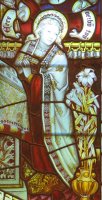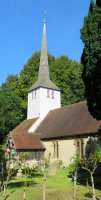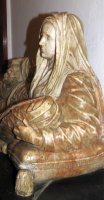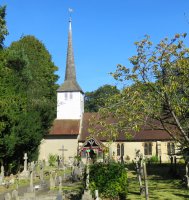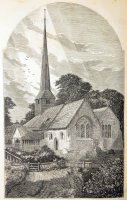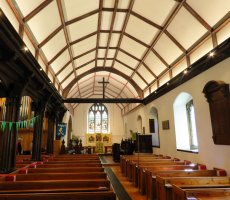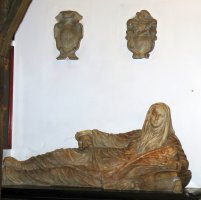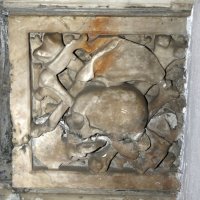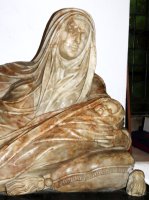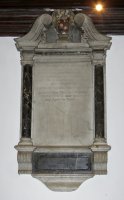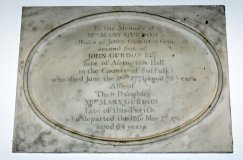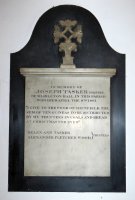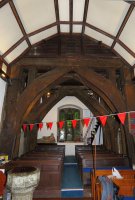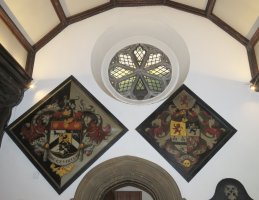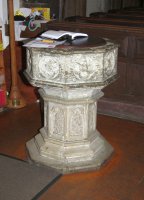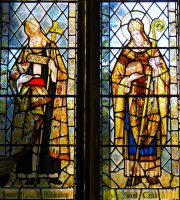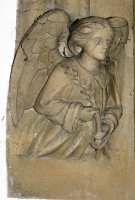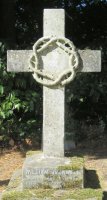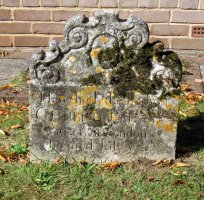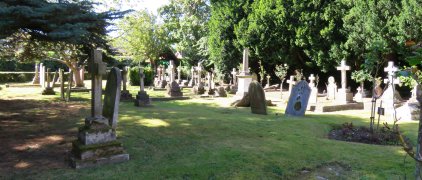Shenfield Church, Essex - Monuments
Shenfield Church, Essex, at the end of the Elizabeth Line out of central London, is of great interest for its partially wooden construction. There is one significant monument, with a reclining, shrouded figure to Elizabeth Robinson, d.1652. Click pictures to enlarge, or hover for captions.
St Mary, Shenfield, is an attractive enough small Essex church, with a distinctively tall, sharp fleche for a spire, on a small wooden tower. The tower is square, the spire octagonal, and to avoid an unpleasant join, we have small roofs like a broach spire as found on larger churches. The nave has a tall tiled roof above smallish windows, the walls being of smoothly cut stone and rather flat in appearance from the south, entrance side despite buttresses.
Shenfield Parish Church.
The Church was erected in the 13th Century, but what we see now is essentially 15th Century, including the tower and spire and the length of nave and chancel, though the thickness of the nave walls is at least suggestive that some of the original body of the Church is concealed within. Those two-light windows on the south side are from a 19th Century restoration, however a small priest's door survives a the chancel end - the picture above right shows the appearance before this restoration. The wooden South porch was also rebuilt in Victorian times, but is essentially from later in the 15th Century. Round to the rear, or north side of the Church from the approach, we have a modern addition, and some older brickwork and rubble; this north aisle was added around the same time as the south porch, along with a chapel – as ever, an aisle to the north is generally the choice on expansion as for superstitious reasons most parishioners refused to be buried on the north side, so the ground would likely have been relatively free of interments.
Interior view.
Inside, then, we have two open roofs, to the nave, and to this north aisle, and remarkably, the dividing pillars and arches are entirely of wood. And looking to the west, the tower, constructed within rather than attached to the end of the nave, is also supported on great oak beams, a satisfyingly massive, heavy structure giving considerable ambience to the Church.
Monuments
Elizabeth [Merrell] Robinson, d.1652, with a note that she died aged just 16 giving birth to her son. A very fine 17th Century statue of white and red-streaked marble. She reclines, partly rolled over towards the viewer, in her funereal shroud, her lower arm cradling the swaddled infant, her further hand resting on a skull, as a memento mori, and which typical of its time, lacks a lower jaw. The carving is very fine: her face with half-lidded eyes, her hands, which have some fingers lost in part, slender and long and delicate; and her shroud gently emphasises her form beneath, thin enough over her feet to indicate the toes. She rests on a thick tasselled cushion familiar from kneeler monuments of the times. Underneath, a great black slab, resting on a heavy altar tomb, of which we can only see the end because of the pew in front and the wall to one side. On the visible side we have a carving of a skull and bones - shoulder blade, pelvis, the limbs of more than one individual, as if from the charnel house; a similar and more graphic example of such a base is that to Lady Bennett in Uxbridge Church.
Carved bones panel.
Adam White, painstaking student of early British tomb sculpture, attributes this statue to Thomas Burman, on the grounds of the similarity between this work, another in Essex at Little Warley to Mary Strutt, and that to Lady Leveson in Lilleshall, Shropshire, the latter of which is convincingly put to Burman's hand. The attribution of the Robinson statue is very plausible, on the grounds of the similarities especially of pose, chins, and hands, however it seems to me that the manner of drapery over the figure is rather different for Mrs Robinson from the other two. Burman has so little sculpture we can be completely confident as being by him, that we cannot be sure.
On the wall behind, and detached from the monument (which itself has been moved) are two shields of arms, one within a cartouche.
And the panels, in date order:
John Ashhurst, d.1676, Citizen and Draper of London, and his fourth wife Elenor, d.1677. A great pale slab of stone against the wall under the tower; this is a ledger stone from the floor of the Church rather than something intended for the wall. With a shield of arms discernible above the inscription, considerable mantling (decoratively treated plumes on a helmet in heraldic designs) and a dog atop the helm.
Elizabeth White, d.1735.
Elizabeth White, d.1735, and her daughters Ann Elizabeth and Elizabeth, undated, and added later, her husband Charles White, d.1753. Typical chunky tablet, with dark streaky marble pillars to the sides, Ionic, supporting a shelf with a swan-necked (curly) pediment, open at the top to admit the painted and carved shield of arms. At the base, a further shelf, curly brackets underneath to the sides and now blank, dark marble panel between, and a shallow apron underneath which is likely recut or a replacement from the original.
Mary Gurdon, d.1771, widow of John Gurdon, and their daughter, also Mrs Mary Gurdon, d.1792 - implying she married into the extended family. Plain rectangular panel with the inscription in an oval. Picture above.
Tasker panel with strange cross.
Joseph Tasker, d.1861, of Middleton Hall, noting his donation of ten guineas to be distributed to the poor of Shenfield in coals and bread at Christmas forever, and signed by his trustees. This is a white-on-black panel, with a complicated open cross standing on a shelf above the inscribed white panel, and black backing cut with a curvy top. Such white-on-black pieces were popular from the end of the 18th Century through much of the 19th Century, and the strangely carved cross gives away its fairly late date (see this page for lots of examples of white-on-black panel monuments).
Captain John Robert Landon, d.1916, in the Battle of the Somme, and his mother Charlotte Elizabeth Bell Landon, d.1917. Pale alabaster panel with a red and white granite surround, this combination being favoured materials of Arts and Crafts panel-makers through until about this time.
We may also note a plain brass panel in a frame to Sergeant Dennis Micaiah Wright, d.1923 of the Gold Coast Survey. And I did not see within the NW lobby, where apparently are limestone tablets to Maria Robinson, d. 1821, and the Reverend Philip Salter, d.1829, and his wife Jane Salter, d.1830.
Visitors to the Church will likely come for the architecture and the atmosphere rather than the monuments, however we have one very good recumbent figure sculpture, and a handful of panels.
Elizabeth Robinson, d.1652.
Also in the Church:
The structure has already been mentioned; the ship's hull-like oak roofs, which apparently were concealed behind a false roof in the last century, and the nave has a great beam across at the point where we might expect a chancel arch or screen - though the chancel was extended twice in Victorian times, so this may be simply a rood beam or tie beam. At the other end, the massive beams of the tower construction, most impressive (picture below left). And the clustered wooden pillars of the later 15th Century dividing the nave from the north aisle. And the pewing, including some 17th Century pews apparently along with the sympathetic modern ones. All this wood gives a good, warm glow to the Church and considerable ambience.
Further wooden furnishings decorate the walls. We have a painted board with the Royal arms, two hatchments (pictured below), a couple of boards commemorating donations to the poor of the parish and a pair of boards commemorating the fallen in the World Wars.
The font, octagonal, white stone with quatrefoils on the sides of the bowl, and leaf carving in the blind windows on the thick stem - see picture above right.
The pulpit, hexagonal with a stone base and steps, and wood above, doubtless 20th Century, and accompanying wooden lectern. Of presumably similar date are the fine wooden rails to the altar area, with small pillars and decorated Gothic arches and piercing, with blind windows with flowers - poppies and thistles - between. There are also some fine ancient chairs and a long bench and other more minor furniture, all adding to the sense of antiquity and fullness of the Church.
The Victorian stained glass, some by Kempe, is good quality, and we may note one pair of Saint Cedd and Samuel Harsnett, Archbishop of York, previously a Vicar at the Church (see picture above); there is a also a brass rubbing of his brass on the wall, from Chigwell Church where he was buried.
A mural on the wall by the porch entrance, 'Suffer little children to come unto me', with a good group of Victorian figures, a little sweet for modern taste perhaps, yet with well-delineated female faces and with a careful composition.
Victorian carved half angels as supporting corbels - see picture below
One of the carved half-angels.
St Mary's Shenfield Churchyard:
The churchyard is not large, but contains some interesting tombstones, and we may note the following:
Crosses are favoured, and include among others ornately carved Celtic crosses and one with a double crown of thorns (pictured below), which is fairly unusual. Quite a nice large one with a tall lily carved on it, with broken flowers at the top indicative of life cut short. Another early 20th Century cross, to Elizabeth Ducker, d.1922, has the cross on a headstone, allowing for lilies to either side. (For a general page about cross monuments in churchyards, see this page).
Round the back, nature has been left to take its course, and there are a couple of heavily overgrown massive tomb chests, one with good stone pillars around it. Compare this to the pink granite one to the Clark family, with a cross on top, and similarly-styled pillars around; more recent, and the granite will last far longer.
Among several flat ledger stones is one very large one tilted to one side, deliberately so on a base, but this left it exposed to the elements and it is unreadable.
1740 headstone.
A few 18th Century headstones, for example one to Cuthbert ..., d.1740, Citizen of London, with a decayed cherub head at the top, and another to Richard Moss, d.1766?, Citizen and Merchant, with a trumpeting winged cherub head and various memento mori of which a snake swallowing its tail (a rather pagan symbol of rebirth) and an hourglass can be discerned.
A curious fragment of Gothic masonry sunk into the ground, covered in moss; it is unmarked and is a remnant of 15th Century window tracery, presumably from the south side windows which were replaced.
Shenfield is the very last stop on the Elizabeth Line into Essex; the easily walkable previous stop, at Brentwood, has a 19th Century church, and a modern Roman Catholic cathedral on a small ancient core, but also has the modest ruins of the Chapel of St Thomas a Becket, dating from the 13th and 14th Centuries, thus fairly contemporary with St Mary Shenfield.
The Church website is at https://stmaryschurch-shenfield.org.uk/the-church/.
Westward are the churches of Essex in London: see this page.. Aside from these, this website includes just a couple of pages on the monuments in Essex-proper churches, and both Lambourne Church and Margaretting Church contain little broach spires and have something of a similar outside look and feel to St Mary's Shenfield.
